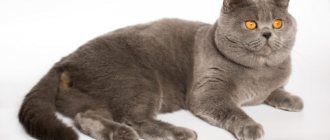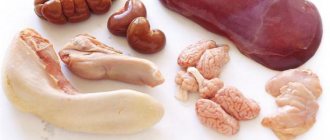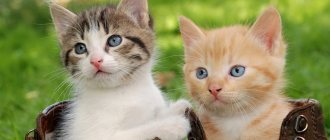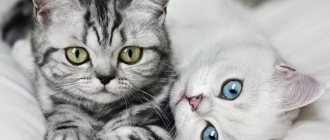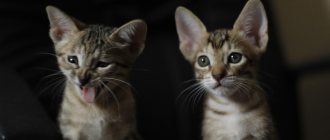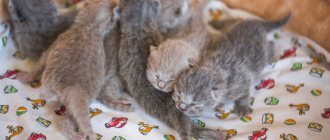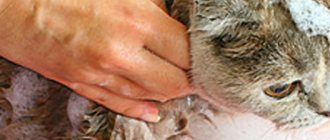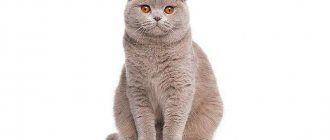The peculiarity of the Scottish Fold cat lies in the shape of its ears, which is not characteristic of other cats; it was once considered a defect, greatly transformed the animal and became the impetus for the creation of a new breed. It was formed with the participation of British and American Shorthair cats.
Not all world organizations enthusiastically accepted the breed with such non-standard ears. Only the CFA and WCF recognized Scottish Fold cats as a test breed in 1974, and four years later, at an elite exhibition in the USA, animals of this breed were met with rave reviews from felinologists and ordinary spectators. Since then, these charming cats began to fully participate in various types of exhibitions.
Breed varieties:
- Scottish Straights have a short coat and straight ears;
- Scottish Fold - short-haired with drooping ears;
- Highland Folds have long fur and ears close to the head.
- Highland Straights are long-haired with straight ears.
In addition to their unusual appearance, Scottish cats also have behavioral characteristics. They love to stand in a column on their hind legs. This is done not to attract attention or to see something better, but to warm up the spine. Another feature is their fear of heights, so they definitely won’t climb on cabinets or hang on curtains; these cats choose more aristocratic methods for their entertainment.
[advertising]
Description of breed standards:
- the body is of medium size, well-developed muscles, the maximum weight of a female is 4-5 kg, a male is 8-10 kg;
- the neck is short and strong;
- the legs are massive, the paws are oval-shaped;
- the tail is short and wide, tapering towards the tip;
- the head is spherical in shape with large plump cheeks, a massive chin and a flattened, humped nose;
- the ears are small, adjacent to the head, rounded at the ends;
- the eyes are large and set wide apart;
- The fur is thick and plush.
Kittens are born with straight ears. Only when they reach the age of 4-5 months can they change their shape and lie on their heads. The shape of their pressing to the head can also be different. Single, double or even triple folding of the ears stands out. The most valuable and expensive of all is the Scottish Fold cat, which has a triple fold of ears that fit snugly to the head, following its contour. Kittens whose ears have not drooped by the time they reach a certain age remain with straight ears for the rest of their lives. The pattern of this process has not yet been clarified, so the number of Scottish Folds in a litter is unpredictable.
Personality of the Scottish Fold
The Scottish Fold cat, whose character is one of its significant advantages, is an animal with a kind soul, calm behavior, aristocratic manners and moderately playful. These cats love their owners very much and get along well with children and other pets. One of the distinctive features of these creatures is their taciturnity; they meow quietly and rarely.
Such cats are perfect for people who do not tolerate fuss and lead a calm, measured life. Even in childhood, kittens of this breed behave moderately and do not cause much damage to the home. But, it’s true, they can hide a variety of small objects in secluded places, for example, glasses, pencils, pens.
[advertising-text]
Scottish Fold cats are very clean and intelligent. Adults are distinguished by affectionateness, calmness and understanding. They may comply if the request suits their interests. But they also show stubbornness if they don’t like something.
Unlike their close relatives, British cats, which can completely ignore the presence of a person, Scottish Folds communicate well with people, choosing a favorite and often staying near it. But despite their devotion, these cats are not at all intrusive; they prefer to be close to a person, but not in his arms.
[advertisement1]
According to many owners, the Scottish Fold cat likes to meditate with its paws stretched forward. These cats also love to sleep on their backs and love massages that are given to them using a comb.
Thanks to its meek disposition, softness and tenderness, the Scottish cat can become a wonderful friend for many years. Many owners consider representatives of this breed to be ideal pets, who are moderately playful, do not misbehave and are easy to train. And the appearance of these animals has never left anyone indifferent.
BRITISH AND SCOTTISH CATS: INTERBREED MATING OF “BRITISH FOLD” IS PROHIBITED
British and Scottish cats have the same roots; mating between them was allowed at a certain period of time. The Scots Fold and the British mated with each other until 2004. This was done according to mutually beneficial calculations: the British received new and interesting colors from their Scottish counterparts, and the Scots, in turn, acquired the plush and thick fur, as well as the massiveness of the British breed. Read more about the differences between the British and the Scots here.
However, in 2004, a decision was made to stop interbreed matings due to the fact that both breeds began to suffer. The Scottish breed began to have bone problems. And British cats lost the beauty of their fur, their bodies became longer, their faces became smaller. Since then, matings between Scottish and British cats have been prohibited, and “British Fold kittens” are not recognized by either system. The British breed is closed, and matings are allowed only within this breed. In addition, many veterinarians speak strictly negatively about such crossing.
As a result of crossing two different breeds and obtaining a “loose-eared British kitten,” it immediately acquires the status of outbred and suffers due to breed characteristics.
Breeding and care
The Scottish Fold cat is unpretentious and does not require special care. Twice a month it is necessary to inspect and clean her ears. Healthy ears inside should be free of plaque and unpleasant odor. When eyes become dirty, they should be cleaned with a damp cotton pad. Representatives of the breed love to use scratching posts and do not damage furniture or wallpaper, which is their significant advantage. If the claws grow too long, they need to be trimmed.
You need to bathe your cat once every 1-2 months. The fur must be combed periodically to prevent tangles from forming. This must be done first in the direction of growth, and then against it. This procedure gives the pet great pleasure.
The diet of these cats should consist of premium dry and important foods and natural products: breast, beef, fish, offal, cereals, eggs, dairy products and fiber. It is forbidden to feed fatty, fried, sweet and salty foods.
The disadvantages of these cats include weak bones and fragile health. But if you take proper care, they can be avoided. Representatives of this breed can live up to 20 years.
To get good offspring, it is important to follow the following rules:
- A Scottish Fold cat should only be mated with a straight-eared cat of the same breed. If the cat has straight ears, then it should be bred with a fold-eared cat.
- It is better to choose a male of a uniform color for mating, as they are most in demand.
- If a female of this breed becomes pregnant, then to avoid complications it is better to squeeze her less and protect her from stress and small children.
Differences between Scots and British
After the introduction of a ban on mating Folds and Britons, the breeds began to have more and more characteristic features and differ from each other not only in their ears.
The Scots are light-boned. The body is elongated, shaped like a rectangle. A round muzzle with the same round and large eyes. And the pressed ears further emphasize the roundness. The facial expression of the Scots is called “baby face”.
The British are much more massive, with a large head, and cheeky. The whisker pads stand out strongly, due to which the cat’s face has a smiling expression. When viewed from the side, the Briton's shape looks more like a square. For Scottish cats, large cheeks are not desirable, as they spoil the roundness of the lines of the muzzle.
Owners and breeders have identified clear differences in the character of representatives of the two breeds. The British are focused on themselves and have a great time alone with themselves. They are reserved, calm, well-mannered. The British woman gets along well with children, she even makes friends with a dog, but she doesn’t like being cuddled.
The Scots are more people-oriented, playful, and sociable. Scottish dogs love to spend time surrounded by their owner. They love all family members without exception.
Read more about the differences between the two breeds here
Scottish Straight
Scottish straights also differ from the English ones - the ears are smaller, not so wide at the base, and set closer to the top of the head. The straight coat is longer, less dense, and lacks the soft, plush British fur coat.
Scottish fold colors
There are several types of colors of Scottish Fold cats:
- solid (solid) - a uniform, uniform shade of fur without spots or patterns, the color can be black, chocolate, lilac, blue or cream;
- tortoiseshell - a chaotic combination of spots of several different shades, the combination should be uniform, the colors should be distributed harmoniously;
- smoky - characterized by a uniform color of the guard coat and a silvery-white shade of the undercoat;
- chinchilla - only an eighth of the hair is colored, and the rest of the hair is white;
- tabby - color with brindle, striped, spotted, marbled patterns;
- bicolor - a combination of white with blue, black or red, it is desirable that white be on the legs, paws, stomach, chest, chin and part of the face;
- van – the main coat color is white, the tail and two spots on the head are of a different color;
- harlequin - the main part of the coat is white, and a fifth of it is of a different shade;
- colorpoint - the shade of the entire coat is light, and the paws, tail, ears, and muzzle are of a contrasting color.
Appearance
Scottish cat
It has a strong, but slender and flexible physique. Medium size. The body is slightly stretched. The chest is wide and voluminous. The head is small in relation to the body, round. The eyes are set wide, open and round. Their color depends on the coat.
Scottish cats come in several varieties. And their ears are also different. Scottish Straights have straight, high-set, long ears that somewhat resemble those of a hare. And in Scottish folds, they hang down and cover the ear opening.
The limbs are strong, long and graceful. The tail is also long. He must be very mobile.
The coat is dense, fine and silky. The length depends on the type of breed.
The color is varied, but the following groups are distinguished:
- plain;
- smoky;
- tabby (tabby) - contrasting with a characteristic pattern on the body;
- chinchilla;
- color point;
- tortoiseshell;
- bicolor.
British cat
The physique is muscular. The medium-sized case is strong and compact. The back is wide and as powerful and well developed as the body.
The head is large and round. The neck is practically absent. She is short, muscular and wide. The British have a medium-sized nose with a wide bridge. The eyes are set wide apart, large and open. The ears are set wide apart and straight, but they are small and rounded at the end. They stand on a wide base.
The limbs are strong and muscular. The tail is short or medium in size with a rounded tip.
The coat is dense, tightly packed with a thick undercoat, plush.
The color has the following varieties:
- solid;
- tortoiseshell;
- smoky;
- tabby;
- bicolor;
- color point;
- chinchilla.
Name for a Scottish Fold cat
The nickname for a cat of this breed should be selected in accordance with its character and appearance. It should highlight all the charm of the pet. It is advisable to keep the name short and clear so that the kitten can easily remember it.
Nicknames for females:
- Ariel,
- Barbara,
- Betty,
- Bead,
- Varvara,
- Greta,
- Jesse,
- Juliet,
- Zara,
- Ingrid,
- Coco,
- Cleopatra,
- Margot,
- Nyusha,
- Cecil,
- Trinity,
- Flossie,
- Helga,
- Yasmina.
Nicknames for males:
- Archie,
- Brand,
- William,
- Smoke,
- Zeus,
- Lucky,
- Oscar,
- Pirate,
- Plato,
- Richard,
- Novel,
- William,
- Caesar,
- Charlie,
- Charles,
- Elf,
- Eugene,
- Yasha.
How much does a Scottish cat cost:
- The price in Russia ranges from 5,000 to 15,000 rubles;
- Price in Ukraine – from 1000 to 6000 hryvnia.
It is better to buy pets of this breed in a professional nursery, where the kitten will have good pedigree and health. Also, along with the kitten, documents and detailed care recommendations are inherited. Kittens are delivered from the nursery at the age of two months, already accustomed to the tray and scratching post.
How to distinguish a British kitten from an ordinary one
Many unscrupulous breeders can sell an ordinary kitten to an inexperienced buyer under the guise of a purebred one. Therefore, it is important to know how to distinguish a purebred animal by appearance. The British kitten has:
- short hair of the same length, that is, some hairs should not be longer than others. Representatives of the breed cannot be fluffy or shaggy, unless it is a British Longhair cat;
- short and strong body with massive legs;
- the British have strict color requirements;
- Eye color matches color.
Character
The British cat has a calm and aristocratic character. Able to withstand the pangs of loneliness while the owner is at work, at which time he usually sleeps. Does not like the owner's affection, as well as attempts at training or education.
Health
The British are in good health and, under optimal conditions, can live up to 15–20 years. The animal is prone to obesity, so you need to monitor its diet.
Owner reviews
Nadia.
One of the most popular breeds in the world. Scottish fold cats are simply beautiful, and I have two of them. One is called Tina (2 years old), the second Jessie (8 months old). They are very kind, affectionate, and having such cats in an apartment is a blessing, especially for children. Their care is minimal, basically the same as for other cats.
Paul.
So my dream came true, in 2021 we bought ourselves a fold-eared kitten. Very beautiful color, already accustomed to the tray and scratching post, we fell in love with him at first sight. Our baby's name is (Adam). We bought it for our son, but it looks like my wife spends more time with him. We are very pleased, we hope that caring for him will not be very difficult.
Catherine.
And I waited for my beloved cat (Asya, 6 months). Scottish cats are very smart, patient with children, easy to train, clean and odorless. Before purchasing, we read reviews from the owners of this breed because we were choosing a pet for children.
History of origin
Scottish cat
The ancestor was the cat Susie, who appeared in 1960 on a farm in Scotland. After the owners noticed the unusual feature of their pet, it was decided to cross it with a British breed cat. The offspring turned out to be the same fold-eared as the mother.
However, not everything is as smooth as it seemed. It took a long time for the new breed to gain recognition from professionals. The thing is that the lop ear gene was negative. It caused diseases of the musculoskeletal system in animals and indirectly caused their death, as it had a detrimental effect on cartilage tissue. Therefore, in 1971, breeding of the breed was banned.
After the fold cat came to America, scientists began to study it. They turned their attention precisely to this gene, which gives the animal an unusual feature. After research, geneticists came to the conclusion that negative consequences occur when two lop-eared individuals are crossed. Troubles can be avoided if one of the pair has straight ears. In this case, the gene will not cause any disorders in the body.
After all the research, in 1976 the Scots again received the right to life.
British cat
It is considered one of the oldest. Because she has been accompanying the residents of England for a long time. Some believe that the cat came to these lands along with the Roman conquerors. Others believe that the animals previously lived in French monasteries and protected cellars from rats and mice. Then, together with the sailors, they got to where they continued to live until the hour of their confession.
No one was specifically involved in breeding the British. However, everything changed at the end of the 19th century. Then English breeders and researchers paid attention to cats. They selected only the best representatives and began breeding the breed. However, British Shorthair cats were only recognized in the 1980s.
Photos of Scottish Fold cats
Description of the breed
Scottish Straight is a cat of small build - 3.5 - 5 kg, with a plush sherish and large eyes.
After the official announcement of the breed, animal standards were established. The cat must meet these standards in order to be called a Scottish Straight and participate in exhibitions.
WCF Standards:
- the body is slightly elongated, muscular;
- the weight of an adult male is 4-5 kg, females 3.5-4.5 kg;
- paws - large, with developed muscles;
- neck - short, muscular;
- the head is large, with a rounded structure of the skull; convex forehead and voluminous cheeks;
- ears - small in size, triangular in shape; set wide, looking up;
- eyes - wide open, round in shape;
- wool - short, plush; the undercoat is thick;
- The color of the iris is orange, blue, depending on the color.
The color of the Scottish Straight can be different, there are no strict requirements. The most common: blue, gray, smoky, tortoiseshell, lilac, cream, red, black, white, black and white, etc.
Ultrasound of animals. Why is it made?- Where can I take veterinary courses and what are they for?
Akita Inu. What kind of breed is this and what are its characteristics?
Photos of Scottish Straights
Read here British Shorthair cat: review of the breed, price, maintenance, care and character traits of the cat (130 photos)
Help the site, share with friends 
When do fold-eared kittens' ears droop?
First of all, it is necessary to understand genetic mechanics. Because you won’t be able to immediately understand whether a kitten is fold-eared or not. All babies are born with a normal ear structure and all newborn kittens have erect ears. But by 15-20 days, the ears of lop-eared babies droop. Thus, at 2 weeks of age, kittens first show their belonging to the fold-eared group. But the process is not yet complete and things can change quite quickly.
Initially, all animals were born with one fold, but later breeders were able to achieve the formation of two, and after a while, three folds on the ears of cats. If at 2 weeks of age only one fold has formed in lop-eared kittens, then there is a high probability that later the cartilage will become stronger and the ear will straighten - in such kittens the ears rise in 50% of cases, and they grow not as folds, but straights.
The presence of a double fold is a guaranteed sign that can be used to distinguish a fold-eared kitten from an ordinary one. In this combination, the risk of encountering erect ears is reduced by another half.
The most reliable sign is the presence of a triple fold. With it, the ear will definitely remain pressed to the head. However, it will be possible to definitively determine lop ears in a kitten only at the age of 3-4 months.
Important! Despite the fact that Scots differ from other breeds in the unusual shape of their ears, some animal lovers prefer to have straight-eared Straights. They are afraid of possible health problems and believe that a cat with raised ears has a more affectionate character.

